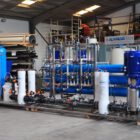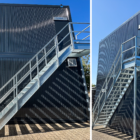A lamella separator is a mechanical separation system that is used to efficiently remove solid and liquid substances from liquid streams. The use of inclined lamellas maximizes the surface area for the sedimentation of particles or the separation of liquid phases. This leads to a significant improvement in separation efficiency compared to conventional sedimentation tanks.
The inclined lamellae promote sedimentation by reducing the distance that particles have to travel. This allows smaller and lighter particles to be separated.
Structure and components
Slat packs:
- Made of plastic, stainless steel or glass fiber reinforced plastic.
- The lamellas are arranged at a certain angle (usually 45° to 60°) to support particle transportation.
Run-in zone:
- Here, the liquid flow is distributed evenly to minimize turbulence.
Separation zone:
- The actual lamella zone in which the separation of solids or liquids takes place.
Drainage zone:
- Purified water is collected and discharged.
Sludge discharge:
- Accumulations of sediment are continuously or periodically removed from the system.
Technical background
Sedimentation efficiency: The inclination and surface of the lamellae reduce the settling time of the particles as the drop height is shortened.
Hydraulic capacity: lamella separators can process high flow rates, as the sedimentation surface is greatly increased by the lamellas.
Compactness: Compared to conventional sedimentation tanks, a lamella separator requires significantly less space, making it ideal for industrial applications with limited space.
Areas of application
Industrial wastewater treatment:
- Removal of solids, metals or organic substances.
- Efficient in sectors such as metal processing, chemicals, the food industry and paper production.
Rainwater treatment:
- Separation of sediments and pollutants from stormwater runoff.
Oil-water separation:
- Removal of oil or emulsions from waste water, e.g. in the petrochemical industry or in workshops.
Pretreatment for biological systems:
- Reduction of the solids load to protect downstream biological processes.
Advantages of a lamella separator
- Efficiency: Higher separation efficiency compared to standard sedimentation tanks.
- Space saving: Compact design with the same or better separation performance.
- Cost-effectiveness: Low operating costs thanks to lower energy consumption and easy maintenance.
- Flexibility: Can be modularly adapted to different flow rates and requirements.
Challenges and requirements
- Risk of clogging: Accumulation of particles between the slats requires regular cleaning.
- Corrosion protection: Depending on the medium, materials such as stainless steel or special plastics must be used.
- Hydraulic control: Even flow distribution is crucial for optimum performance.
Conclusion
Lamella separators are a highly developed solution for the efficient separation of solids and liquids in industrial water and wastewater treatment. Thanks to their compact design, high performance and versatility, they are indispensable in many industries. ALMAWATECH offers customized lamella separators that are optimized for specific requirements and provides support with comprehensive planning and maintenance services.
For further information on our products, please feel free to contact us at any time!








